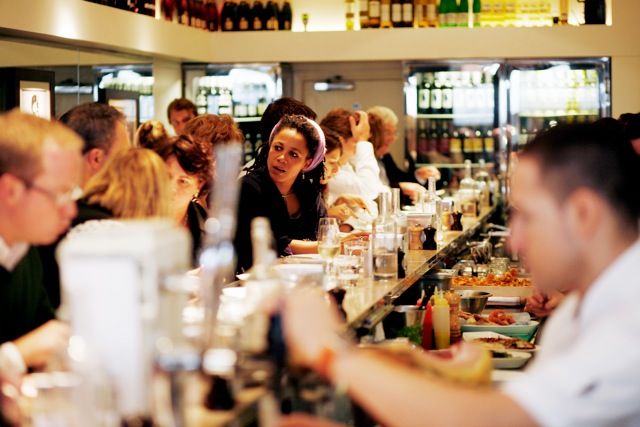It is the consistency and reliability of Rioja that makes the region such an important category for any buyer or sommelier looking to put a wine list together, says Bibendum.
It might be too late in the day to be making wholesale changes to your wine list in the week before Christmas, but if you have a “to do” list for the 2018 then make sure you put Rioja on it. Last week we heard from a number of wine buyers, restaurateurs and distributors about why and how Rioja has become such a mainstay of their wine lists. And, yes, why it can be a great alternative to other Old World classics, particularly expensive French ones, for the festive dinner table.
Richard Bigg, managing director of Camino, the specialist Spanish restaurant chain, would have no hesitation in offering Rioja as part of any Christmas meal. As he said: “Definitely so. There are so many styles, and the majority of reds are not too tannic, so best would be something that hasn’t spent too long in barrel. The whites are a good way to kick off if unoaked, but the oaked styles have the richness and depth that would be a perfect match for turkey, stuffing and all the trimmings.”
Spain as a whole and Rioja, in particular, has been working very well for national wine distributor, Bibendum, as Lisa McBain, its supplier manager for Spain, explains: “Rioja is one of the most famous wine regions in the world and yet most people know little about its rich array of terroirs. Producers such as David Sampedro at Bodegas Bhilar are increasingly focused on expressing the characters of individual villages and vineyard sites, and is transforming the image of Spain’s leading DOCa. Viura (white Rioja) is massively underrated and offers excellent value for money.”

Bibendum’s John Graves said Rioja is ideally placed to work across all channels of the on-trade
John Graves, Bibendum’s on-trade channel director, added: “Rioja is still very much driven by Crianza and below, which is predominantly price-driven in the casual dining market, while the big names can command higher prices in premium venues. However, there’s a growing excitement around modern producers like Bodegas Bhilar, which champions organic, low yield farming and the subdued use of oak.”
Maximising Rioja sales
For him the best way to get the most out of your Rioja sales is to be upfront and bullish about what it can offer. “Pair Rioja with food. Upsell to reserve or above – by the glass promotions on an upsell works really well, as do pouring from a magnum. Rioja is a safe bet for customers to trade up, so is very valuable. White Rioja is a tiny part of the market and very price driven. Entry-level Viura can do well, while the food-friendly, oaky whites are more of a hand-sell.”
It is also a great region, he added, to push customers in to other areas of Spain: “Simply use Rioja as a benchmark. ‘If you like Rioja, you will love Ribera del Duero/Jumilla/Toro’ etc.”

Pushing whites
In our previous article looking at how Rioja can be a good alternative to French wine classics, Roger Jones, Michelin-starred chef of The Harrow at Little Bedwyn, urged buyers to look seriously at its white wines. “It’s a good time to be promoting white Rioja in the winter as it brings a glow of sunshine and vibrancy. It is also one of the best value wines available.”

Rioja’s Ricardo Aguiriano
Which will be welcome news to the region’s Consejo Regulador DOCa Rioja that is placing a big emphasis on white wines from Rioja in the coming years. Ricardo Aguiriano, global marketing director, explains why: “Three years ago we decided to work with our wine producers to see how we can make more of our white wines. We thought it would take a lot of time to make this happen, but surprisingly just within a couple of years not only has the quality impressed us, but so have the styles and the diversity of white wines we are being able to produce.”
It seems the feedback from the trade, and particularly importers calling for more white wines has had a big impact in the region. Aguiraino explains: “But to make it happen we needed our wine producers to also start to pay good prices for white wine grapes from their growers. To make good white grapes is expensive, and it’s much easier for them to make reds grape varieties. Wineries have also traditionally paid more for red grapes than white ones. So it has really come down to a good connection between the growers and the wine producers. The growers need a commitment from their producers that they will pay a good profitable price for their white wine grapes. This balance has been achieved in the last few years compared to say 10 to 15 years ago when growers did not take the same amount of care towards the white grapes as they did as the reds.
Bibendum’s facts and figures on Rioja
According to CGA, sales of Spanish wine (led by Tempranillo) reached £115million in 2017 in the UK on-trade, an increase of 0.78% on 2016. At Bibendum our Spanish wine sales increased at an even higher rate than this UK average. Sales of white, rosé and red Rioja showed positive growth, with the biggest growth for red Rioja.
Rioja Exporters Group statistics for September:
- Exports made up 36.5% of Rioja sales over the 12 months from September 2016 to August 2017.
- The UK remains Rioja’s largest export market, accounting for 33% of exports.
- For the year ending August 2017, 89.6 % of global Rioja exports were red, 4.7% rosé, and 5.7% white.
- 58.8% of exports to the UK are Sin Crianza wines, 13.2% are Crianza, 24.5% Reserva and 3.5% Gran Reserva.
Nielsen statistics: MAT to 17.06.17
- Within the Spanish category, Rioja continues to assert its dominance as Spain’s flagship wine region, and continues to account for almost half of Spanish value at an impressive 49.4% and 38.6% of Spanish volume.
- The average price for Rioja currently sits at £6.75 per bottle vs market average £5.51.
- Over 85.8% of Rioja is sold at over £6, compared to 24% for the wider UK market, reinforcing consumers’ trust in the region demonstrated in their willingness to trade up when it comes to purchasing wines from Rioja.
- Considering the different categories, shipments to the UK are as follows: Joven up 17.2%; Crianza down 9.5%; Reserva down 9.5%; Gran Reserva up 20%.
- White Rioja has increased its market share by 53.8% to 6.4%, indicating that consumers are increasingly interested in exploring the diversity Rioja has to offer.
- White wine shares within the Spanish category continue to hold a quarter of the market share – at 23.4% – demonstrating the opportunity that exists for Rioja to grow representation in this category.










































